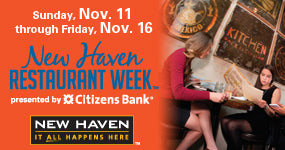It seems a likely bullet point on a bucket list: “Learn flamenco dancing.” Or perhaps one of those epiphanies that occurs over drinks: “Flamenco! We should totally try that!”
But in the basement of a church in Wooster Square—hardwood-floored, perfect for stamping with nail-toed flamenco shoes—the beloved Spanish tradition is very much a reality. This is the Melinda Marquez Flamenco Dance Center, where the accomplished instructor of the same name teaches regular classes for all levels.
Marquez looks like she was born to dance, with long legs and a confident command of her body; and she has, in fact, been dancing since she was a teenager, later touring nationally and all over the world, training with some of the most notable talents in Flamenco, as well as choreographing original works.
sponsored by
“It’s so incredibly empowering,” Marquez says from the undercroft of The Episcopal Church of St. Paul and St. James on Olive Street. Indeed, empowerment is built into the form. Flamenco involves three players—a guitarist, a singer and a dancer—and it’s the dancer who leads the trio, expressing his or her own interpretations in the moment.
“You can bring your true self to it,” says Marquez, adding that once we’re adults, most of us have learned to keep ourselves in check. Flamenco, she says, is about being “free.”
Classes range from the “Absolute Beginner” to advanced levels, with specializations such as “Castanet Technique” and “Cajón” (set to a Peruvian drum of the same name). Both private and group sessions are available for adults and children. “It’s an extremely supportive atmosphere. Everybody is comfortable around one another,” Marquez says, and the students beginning to show up for their next class nod their heads in agreement.
The 6:15 session tonight includes a group of ten women and one man (Marquez says males are less plentiful but certainly present at the Center) who chat excitedly with each other as they begin stretching and practicing a few moves. They are encouraged to wear whatever they feel comfortable in, and some, but not all, wear traditional, long flamenco skirts. Most wear high-heeled Flamenco shoes to issue staccato stamps at appropriate intervals.
To begin, Marquez pushes a button on the stereo in the corner. A thumping, rhythmic beat fills the room. She instructs the class that they’ll start by doing simple handwork, illustrating the importance of getting the fundamentals.
Even the basics—even the most subtle, minute movements—have soul, and that makes it thrilling for spectators to behold. Marquez organizes regular public performances with live music and colorful attire, featuring ensemble dancers from her center. This October the Center presented “Flamenco: Made in USA,” a tribute to the American Flamenco dancer Roberto Lorca (one of Marquez’s original mentors), performed at the Cooperative Arts Magnet High School in New Haven.
Marquez collaborates with a vibrant array of artists in both New Haven and New York, where she initially learned to dance, meaning talented guitarists, singers and other performers are usually on hand to boost the productions. Her career, she says, is “about many things,” from teaching to choreography to performance. She says she isn’t sure what lies ahead.
Right now, though, she’s focused on leading a class. As her students move from handwork to practicing more complicated sequences, they’re starting to warm up, hips beginning to sway. They could be home, spending their evening on more mundane endeavors; instead, they’ve come to learn, and they aren’t holding back.
And that’s kind of the point. Flamenco can be an ego trip, says Marquez, but in a good way. “It’s a completely musical and kinesthetic turn-on to be guiding that whole thing.” As the tempo increases, and the dancers get into it, keeping up with the beat, I think I understand what she means.
Melinda Marquez Flamenco Dance Center
57 Olive Street, New Haven (map)
(203) 361-1210
www.melindamarquezfdc.org
Written and photographed by Cara McDonough.









